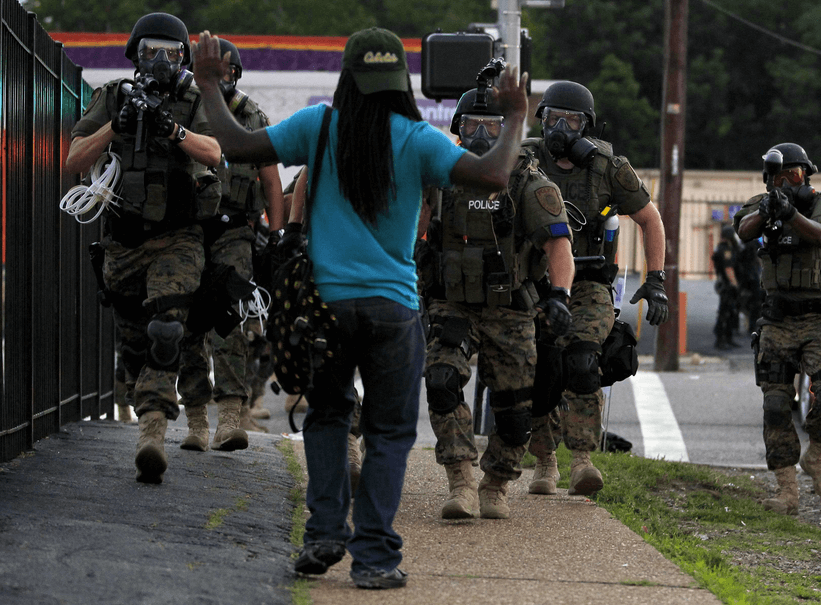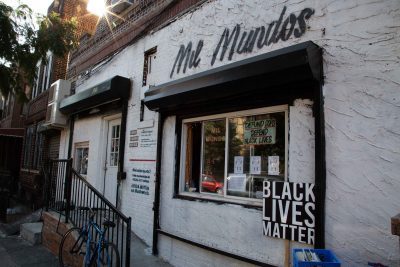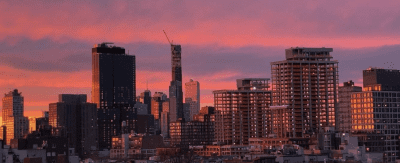Ferguson Is All Around Us: All Americans Need to Pay Attention to the Killing of Mike Brown


credit: AP/Jeff Roberson
Here is what we know now: On Saturday, August 9th, an unarmed 18-year-old named Michael Brown was shot at least six times—four times in the right arm, twice in the head—by police officer Darren Wilson, a six year veteran of the force. An autopsy has revealed that every shot struck Brown in the front of his body, simultaneously corroborating eye witness accounts which claimed Brown was facing Wilson with his hands raised, and contradicting those which asserted that Brown was shot while running away. We know Brown had shoplifted about $40 worth of cigars from a nearby convenience store. But we also know that Officer Wilson was unaware of this theft when he encountered Brown and Dorian Johnson walking down the middle of a street, rather than on the sidewalk. We know there was a confrontation. We know Brown was killed. We know that Officer Wilson did not immediately—or in any sort of a timely fashion—report the shooting. We know that no ambulance was called. We know that Brown’s body remained in the street for hours. But many other elements—as indicated by those counter-indicative eye witness accounts—surrounding the killing of this young man remain unclear, further fueling the fiery situation that continues apace in Ferguson. One thing, though, that remains troublingly clear to anyone paying attention is that the death of Michael Brown is not just an indication of what is wrong with Ferguson, Missouri, rather it is an indication of what is wrong all over America.
Today in the New York Times, former Missouri state senator and current professor at the New School, Jeff Smith, wrote an excellent editorial in which he laid bare the institutional framework which allows for a death like Brown’s to happen. Smith writes that “the racial power disparities we’ve seen in Ferguson” go far beyond and simplistic understanding of racism as being motivated by some irrational, visceral hatred for people that look different from you, rather, to understand what really motivates racist power structures, you need to “understand that it’s not only about black and white. It’s about green.” Smith explains how Ferguson—which in the last 25 years has seen an extraordinary demographic shift (“in 1990, it was 74 percent white and 25 percent black; in 2000, 52 percent black and 45 percent white; by 2010, 67 percent black and 29 percent white”)—is now a majority black community with an almost exclusively white power structure (including a City Council with a lone black member, and a police force comprising 6% black officers).
Furthermore, Smith reveals that one of the primary ways that Ferguson and surrounding, demographically similar municipalities collect revenue is through income “generated from traffic tickets and related fines .” And who exactly do you think gets stopped in far greater numbers than their percentage of the population would dictate? Did you guess black residents? Ding ding ding. You’re right! You win nothing except the right to recognize that we live in a society with such structural inequality as to be risible if it didn’t lead to the disenfranchisement and deaths of so many oppressed people. Smith reveals, “In Ferguson last year, 86 percent of stops, 92 percent of searches and 93 percent of arrests were of black people—despite the fact that police officers were far less likely to find contraband on black drivers (22 percent versus 34 percent of whites).” And since “municipal reliance on revenue generated from traffic stops adds pressure to make more of them,” meaning that when a white officer sees two young black men jaywalking, there is explicit pressure on that officer to yell at them and write them tickets because those tickets pay for that officer’s salary.
Smith rightly concludes that this type of system “worsens inequality, as struggling blacks do more to fund local government than relatively affluent whites,” and calls on places like Ferguson to look to consolidate with surrounding communities, because in situations like these, size matters. More people means more money, and more money means more power, and more power means more attention, and more attention means politicians who might be forced to actually do something for all the people instead of just the select few. All of which sounds pretty good, and is obviously worth trying in Ferguson itself, and the Fergusons all over America. There are countless communities in this country that have suffered because of systemic racism and would greatly benefit from being able to “create economies of scale, increase borrowing capacity to expand economic opportunity, reduce economic pressures that inflame racial tension, and smash up the old boys’ network” so as not to be subject to the injustices that currently prevail in Ferguson and elsewhere.
But what about those places that are already consolidated? What about those places already flush with money and power and attention? What about New York? In so many ways, Ferguson feels far away from us here, despite the fact that it was only a month ago that a New York City police officer killed Eric Garner, an unarmed black man, for allegedly selling loose cigarettes, an offense as minor as jaywalking. And similarly to the way in which Ferguson coffers are filled with by fining its struggling citizens, New York residents have been facing an onslaught of “quality of life” ticketing, which undoubtedly serves as a boon to the city’s finances. But just as we should not accept the criminalization of an entire race of people in Ferguson, we should also not accept it here. We should not nod along with or ignore completely as our supposedly progressive mayor tells us to ignore all the evidence to the contrary and blindly trust the police. De Blasio recently said that “every New Yorker should agree to do what they need to do as a citizen and respect the police officer and follow their guidance,” because if we do that justice will prevail.
But whose justice is that exactly? Why should anyone have any faith that the court system will protect their rights over those of the state? Why should anyone retain belief in a justice system that, as Natasha Lennerd points out in Vice, involves “at least 94 percent of criminal cases in this country [not even going to trial, but ending] in guilty pleas as the threat of draconian mandatory minimum sentencing runs high?” Why should anyone promise to be well-behaved and docile and orderly like sheep being led to slaughter? The only people whom this system protects are those who are already in a position from which they are rarely threatened. Those of us who are cosseted enough by our racial and economic privilege as to be able to coast by easily enough, or talk our way out of the rare encounter we might have with the law,* ought to be aware of how precarious our position is, and how it rests on a foundation of the oppression of others. New York City might not have erupted in the days following the death of Eric Garner (or, for that matter, Kimani Gray, Ramarley Graham, Timothy Stansbury, Sean Bell, Amadou Diallo), but that doesn’t mean that we don’t have similar problems to those that exist in Ferguson; we just continue to ignore them, at our own peril.
*This, by the way, is one of the most infuriating aspects of the shoplifting angle in the killing of Michael Brown. Surely the percentage of privileged, white teenage girls who shoplift is close to 100%, and I await the day anyone says they deserve to pay for that crime with their lives.
Follow Kristin Iversen on twitter @kmiversen
You might also like 


























